Related Research Articles

Shamanism is a religious practice that involves a practitioner (shaman) interacting with the spirit world through altered states of consciousness, such as trance. The goal of this is usually to direct spirits or spiritual energies into the physical world for the purpose of healing, divination, or to aid human beings in some other way.
The Manchus are a Tungusic East Asian ethnic group native to Manchuria in Northeast Asia. They are an officially recognized ethnic minority in China and the people from whom Manchuria derives its name. The Later Jin (1616–1636) and Qing (1636–1912) dynasties of China were established and ruled by the Manchus, who are descended from the Jurchen people who earlier established the Jin dynasty (1115–1234) in northern China. Manchus form the largest branch of the Tungusic peoples and are distributed throughout China, forming the fourth largest ethnic group in the country. They are found in 31 Chinese provincial regions. Among them, Liaoning has the largest population and Hebei, Heilongjiang, Jilin, Inner Mongolia and Beijing have over 100,000 Manchu residents. About half of the population live in Liaoning and one-fifth in Hebei. There are a number of Manchu autonomous counties in China, such as Xinbin, Xiuyan, Qinglong, Fengning, Yitong, Qingyuan, Weichang, Kuancheng, Benxi, Kuandian, Huanren, Fengcheng, Beizhen and over 300 Manchu towns and townships. Manchus are the largest minority group in China without an autonomous region.
Manchu is a critically endangered East Asian Tungusic language native to the historical region of Manchuria in Northeast China. As the traditional native language of the Manchus, it was one of the official languages of the Qing dynasty (1644–1912) of China, although today the vast majority of Manchus speak only Mandarin Chinese. Several thousand can speak Manchu as a second language through governmental primary education or free classes for adults in classrooms or online.

Romance of the Three Kingdoms is a 14th-century historical novel attributed to Luo Guanzhong. It is set in the turbulent years towards the end of the Han dynasty and the Three Kingdoms period in Chinese history, starting in 184 AD and ending with the reunification of the land in 280 by the Western Jin. The novel is based primarily on the Records of the Three Kingdoms, written by Chen Shou in the 3rd century.

The Tungusic languages form a language family spoken in Eastern Siberia and Manchuria by Tungusic peoples. Many Tungusic languages are endangered. There are approximately 75,000 native speakers of the dozen living languages of the Tungusic language family. The term "Tungusic" is from an exonym for the Evenk people (Ewenki) used by the Yakuts ("tongus").

The Brahmanas are Vedic śruti works attached to the Samhitas of the Rig, Sama, Yajur, and Atharva Vedas. They are a secondary layer or classification of Sanskrit texts embedded within each Veda, which explain and instruct on the performance of Vedic rituals. In addition to explaining the symbolism and meaning of the Samhitas, Brahmana literature also expounds scientific knowledge of the Vedic Period, including observational astronomy and, particularly in relation to altar construction, geometry. Divergent in nature, some Brahmanas also contain mystical and philosophical material that constitutes Aranyakas and Upanishads.
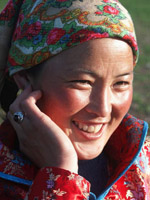
The Daur people, Dagur, Daghur or Dahur are a Mongolic people originally native to Dauria and now predominantly located in Northeast China. The Daur form one of the 56 ethnic groups officially recognised in the People's Republic of China. They numbered 131,992 according to the latest census (2010) and most of them live in Morin Dawa Daur Autonomous Banner in Hulun Buir, northeastern Inner Mongolia and Meilisi Daur District in Qiqihar, Heilongjiang, Northeast China. Some Daur people also live near Tacheng in Xinjiang.
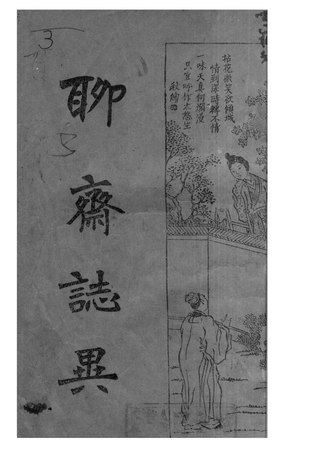
Liaozhai zhiyi, sometimes shortened to Liaozhai, known in English as Strange Tales from a Chinese Studio, Strange Stories from a Chinese Studio, Strange Tales from Make-Do Studio, or literally Strange Tales from a Studio of Leisure, is a collection of Classical Chinese stories by Qing dynasty writer Pu Songling, comprising close to 500 stories or "marvel tales" in the zhiguai and chuanqi styles, which according to some critics, served to implicitly criticise societal problems. Written over a period of forty years from the late 1600s and ending in the early 1700s, it circulated in manuscripts that were copied and recopied among the author's friends but did not appear in print until 1766. Since then, many of the critically lauded stories have been adapted for other media such as film and television.
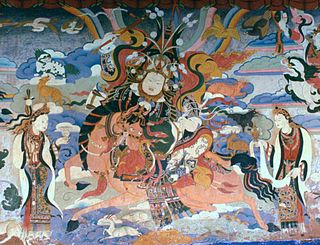
The Epic of King Gesar, also spelled Kesar or Geser, is an epic from Tibet and Central Asia. It originally developed between 200 or 300 BCE and about 600 CE. Following this, folk balladeers continued to pass on the story orally; this enriched the plot and embellished the language. The story reached its final form and height of popularity in the early 12th century.

Turkic mythology refers to myths and legends told by the Turkic people. It features Tengrist and Shamanist strata of belief along with many other social and cultural constructs related to the nomadic and warrior way of life of Turkic and Mongol peoples in ancient times. Turkic mythology shares numerous ideas and practices with Mongol mythology. Turkic mythology has also been influenced by other local Asiatic and Eurasian mythologies. For example, in Tatar mythology elements of Finnic and Indo-European mythologies co-exist. Beings from Tatar mythology include Äbädä, Alara, Şüräle, Şekä, Pitsen, Tulpar, and Zilant.

Tengrism is a religion originating in the Eurasian steppes, based on shamanism and animism. It generally involves the titular sky god Tengri, who is not considered a deity in the usual sense but a personification of the universe. According to some scholars, adherents of Tengrism view the purpose of life to be in harmony with the universe.
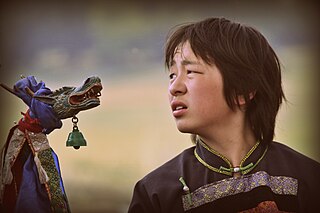
A large minority of people in North Asia, particularly in Siberia, follow the religio-cultural practices of shamanism. Some researchers regard Siberia as the heartland of shamanism.
Wu is a Chinese term translating to "shaman" or "sorcerer", originally the practitioners of Chinese shamanism or "Wuism".
Seong Baek-in was a South Korean linguist who was professor emeritus of linguistics at Seoul National University. His primary area of research is on the Manchu language.
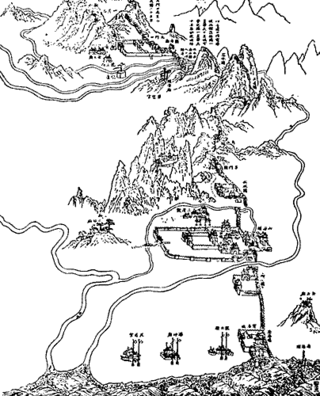
The transition from Ming to Qing or the Manchu conquest of China from 1618 to 1683 saw the transition between two major dynasties in Chinese history. It was a decades-long conflict between the emerging Qing dynasty, the incumbent Ming dynasty, and several smaller factions. It ended with the consolidation of Qing rule, and the fall of the Ming and several other factions.

Mongolian shamanism, known as the Böö Mörgöl in Mongolian and more broadly called the Mongolian folk religion or occasionally Tengerism, refers to the animistic and shamanic ethnic religion that has been practiced in Mongolia and its surrounding areas at least since the age of recorded history. In the earliest known stages it was intricately tied to all other aspects of social life and to the tribal organization of Mongolian society. Along the way, it has become influenced by and mingled with Buddhism. During the socialist years of the twentieth century, it was heavily repressed, but has since made a comeback.
Shamanism was the dominant religion of the Jurchen people of northeast Asia and of their descendants, the Manchu people. As early as the Jin dynasty (1115–1234), the Jurchens conducted shamanic ceremonies at shrines called tangse. There were two kinds of shamans: those who entered in a trance and let themselves be possessed by the spirits, and those who conducted regular sacrifices to heaven, to a clan's ancestors, or to the clan's protective spirits.
Manchu became a literary language after the creation of the Manchu script in 1599. Romance of the Three Kingdoms was translated by Dahai. Dahai translated Wanbao quanshu 萬寶全書.
Identity in China was strongly dependent on the Eight Banner system during the Manchu-led Qing dynasty (1644–1912). China consisted of multiple ethnic groups, of which the Han, Mongols and Manchus participated in the banner system. Identity, however, was defined much more by culture, language and participation in the military until the Qianlong Emperor resurrected the ethnic classifications.

Nellie Yu Roung Ling, also spelt Nelly, was a Hanjun Plain White bannerwoman and dancer, who is considered "the first modern dancer of China". She was the younger daughter of Yu Keng and Louisa Pierson, the other one being Lizzie Yu Der Ling. Although not a member of the Qing imperial family, Roung Ling was given the title of "commandery princess" while serving as a lady-in-waiting for Empress Dowager Cixi.:268 She was also known as Yu Roon(g) Ling, especially in the works of her sister Der Ling.:267 She was referred to as Madame Dan Pao Tchao after her marriage to the General Dan Pao Tchao, and Princess Shou Shan, a title appeared on the cover of her 1934 historical novella about the Fragrant Concubine, a name Sir Reginald Johnston claimed she never used.:xii
References
Notes
- ↑ Durrant 1979 , p. 339
- ↑ Richtsfeld 1989 , p. 117
- ↑ Heissig 1997 , p. 200
- ↑ Volkova 1961 , p. 1
- ↑ Yen 1980 , p. 88
- ↑ Pang 1995 , p. 34
- ↑ Yen 1980 , p. 88
- ↑ Melles 1987
Sources
- Durrant, Stephen W. (Winter 1979), "The Nišan Shaman Caught in Cultural Contradiction", Signs, 5 (2): 338–347, doi:10.1086/493712, JSTOR 3173565
- Yen, Alsace (1980), "Book Review: The Tale of the Nišan Shamaness", The Journal of American Folklore, 93 (1): 88–90, JSTOR 540231
- Richtsfeld, Bruno (1989), "Die Mandschu-Erzählung "Nisan saman-i bithe" bei den Hezhe", Münchner Beiträge zur Völkerkunde, 2: 117–155
- Pang, T. A. (1995), "Rare Manchu manuscripts from the collection of the St. Petersburg branch of the Institute of Oriental Studies, Russian Academy of Sciences" (PDF), Manuscripta Orientala, 1 (3): 33–46
- Heissig, Walther (1997), "Zu zwei evenkisch-daghurischen Varianten des mandschu Erzählstoffes "Nisan saman-i bithe"", Central Asiatic Journal (41): 200–230, ISBN 978-3-447-09025-4